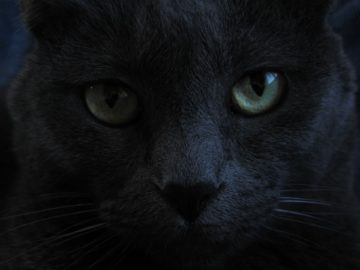
During the European witch hunts and trials thousands of cats were put to death, accused as they were alongside their human “familiars.” The legacy of this tragic era is still with us, even though we tend to jest about Halloween cats and the old superstitions. But this negative view of cats contradicts their actual role throughout human history. Cats have almost always symbolized protection and good fortune.
In the earliest feline images found on cave walls and carved out of stone, wildcats are companions and guardians to the Great Goddess–often flanking a mother goddess figure in the act of giving birth. Such imagery has been found in ancient sites across Europe, Africa, India and the Middle East.
Terri Windling, “Feline Folklore“
Cat is mau in ancient Egyptian, mao in Cantonese–alliterations and imitations of the sound a domestic cat makes, and, as Windling notes in the article cited above, “a mother-syllable.”
Long before cats featured in folklore and fairy tales, they rose to phenomenal status in Ancient Egypt, progressing from rodent-killing protectors of grains to household pets to god/dess. Cats transformed Egyptian culture and were transfigured by it–shaped, physically and metaphorically, into the cozy, domestic creatures we know and love today. Or so we thought.

The latest research provides evidence that cats and humans coexisted even earlier than previously believed. Thousands of years before their arrival in Egypt, cats in the Near East protected stored crops and conquered the hearts of the farmers who grew them.
One striking example is a 9,500 year-old cat that was buried in a human grave on the island of Cyprus, where cats are not native. Some 6,000 years ago, after Neolithic farming practices began spreading, it seems that these people-friendly felines foraged northward and westward with humans into Bulgaria and Romania.
Maya Wei-Haas, “How Cats Conquered the World“
Domestic cats in ancient Egypt represented a “second wave” of feline dominance over humankind.
The researchers even found evidence of these human-loving cats at the Viking port of Ralswiek on the Baltic Sea, says Geigl, and the Iranian port of Siraf, confirming that the faithful mousers commonly joined sailing crews. And the cats’ venture didn’t end there: For thousands of years, these furry globetrotters have followed humans wherever they went, conquering every continent except for Antarctica.
Maya Wei-Haas, “How Cats Conquered the World“
According to Marie-Louise von Franz in The Interpretation of Fairy Tales, animals feature in our oldest, deepest stories. We project onto them our own “archetypal” tendencies. As intimate as we have been with cats for a very long time, it comes as no wonder then that we have so many stories about them, including a long list of feline fairy tales.

Perhaps the best known from the European fairy tale canon is “Puss in Boots.” There are, however, many other cats to consider:
- “Kisa the Cat” in which a young princess’ long lost companion, in the form of a cat, rescues her from a menacing giant. Kisa the cat is then released from an evil enchantment and returned to her original form as a princess. The two young women will be inseparable for the rest of their lives.
- “Baba Yaga” is the Russian tale of a terrifying, iron-toothed witch outwitted by her niece with the aid of a black cat.
- Countess d’Aulnoy’s “The White Cat” in which an aging king sets his sons to the task of earning their right to rule by procuring the handsomest dog in the world. The story focuses on the youngest who amasses a collection of dogs in all shapes and sizes. Concerned that he hasn’t yet found the best dog, he sets out into the woods where he finds a castle so fine it defies imagination. Disembodied hands guide him inside to a blazing hearth where he is disrobed and put into new clothes. Disoriented, he wanders into a room where an orchestra of cats is playing: “Suddenly each began to mew in a different tone, and to scratch the strings of their guitars with their claws. It was the strangest music that had ever been heard.” Then the mistress of the castle appears, a lovely white cat who extends her hospitality to the prince in the form of a grand feast. “You, madam,” says the prince, “are a cat of very rare description.” The white cat is really an enchanted princess who wins the throne for the youngest son and unites his family in the process.
- “The King of the Cats” is an ancient tale from the British isles in which the sexton and his wife discover the truth about their old tom in a most surprising fashion.
The world is full of lucky cats, artful cats, traveling cats, sassy cats…I invite you to get your fill here.
(Cross-posted at Luna Station Quarterly)
- Top Image by LisaRedfern at Pixabay.com
- Illustrations by Adrienne Segur (Public Domain)

